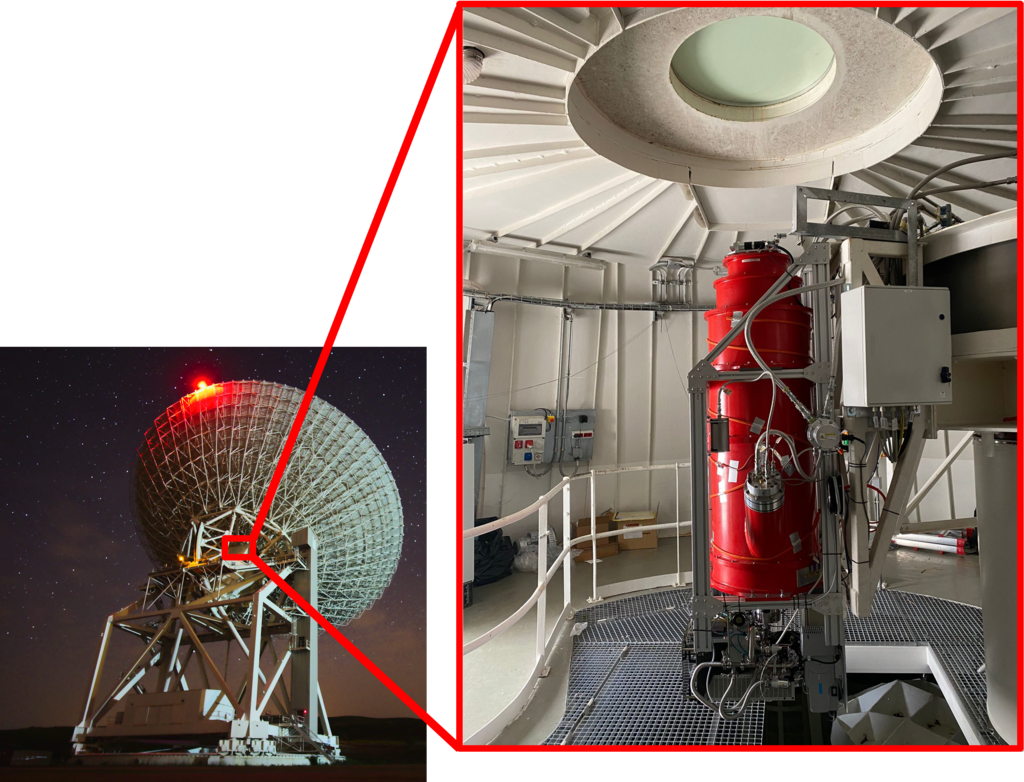
MISTRAL: Sapienza's contribution to the Sardinia Radio Telescope
The installation of MISTRAL, built by a team of researchers from the Physics Department of Sapienza University of Rome, for the Sardinia Radio Telescope, the imposing 64-metre diameter radio telescope of the National Institute of Astrophysics (Istituto nazionale di astrofisica - Inaf), located in San Basilio, Sardinia, has been completed. The installation concludes four years of intense work by the G31 team of the Department of Physics, led by Paolo de Bernardis, scientific head of MISTRAL at Sapienza.
"The heart of MISTRAL is an array of 415 kinetic inductance detectors, the result of a collaboration between Sapienza and CNR-IFN in Rome," say Alessandro Paiella, Federico Cacciotti and Giorgio Pettinari, who were in charge of the design, realisation and characterisation of the detectors.
"The detectors are illuminated by an optical system consisting of two silicon lenses and a series of resonant filters," adds Marco De Petris, MISTRAL's head of optics. "This transfers the image of the sky produced by the telescope onto the mosaic, enlarging and correcting its field of view and eliminating all wavelengths outside the band of interest".
"The detectors are cooled down to just 0.2 degrees above absolute zero, or -273 degrees Celsius, by a complex cryogenic system, which allows them to be kept in operation for the duration of the observations, eliminating the strong disturbances due to thermal agitation," highlights Alessandro Coppolecchia, MISTRAL's cryogenics manager.
"In addition to the excitement of completing the hardware development, there is great anticipation for the scientific results that will come from using MISTRAL. Thanks to the very low operating temperature and hundreds of detectors operating simultaneously, the instrument is extremely efficient for the detailed observation of sources such as galaxy clusters", add Giuseppe D'Alessandro and Alessandro Novelli, who handled MISTRAL's assembly and housekeeping.
"When photons from the cosmic microwave background pass through clusters of galaxies, they have a certain probability of interacting with the electrons of the hot gas that permeates the entire volume of the cluster, and slightly increase their energy, thus shortening their wavelength. This results in a deficit of cosmic microwave background photons at wavelengths longer than 1.4 mm, and an excess of photons at shorter wavelengths", points out Giovanni Isopi, who is in charge of MISTRAL's readout electronics and data.
"MISTRAL, at a wavelength of 3 mm, will measure the photon deficit of the cosmic microwave background with great efficiency and detail, observing against the light a large number of galaxy clusters and filaments of gas between clusters," highlights Elia Battistelli, MISTRAL Project Manager. "This allows us to quantify the structure and dynamics of the cosmic web, the intricate web of filaments of matter that contains most of the normal and dark matter in the universe".
"This matter is invisible in optical observations that can only reveal photons emitted by stars in galaxies, which are only the tip of the iceberg of the large-scale structure of the universe", add Francesco Piacentini and Fabio Columbro, who are in charge of MISTRAL's readout and calibration.
"This is why," concludes MISTRAL instrument scientist Silvia Masi, "instruments such as MISTRAL and OLIMPO, built by the Physics Department team to observe the excess of photons at short wavelengths by working from a stratospheric balloon, and a few others in the world, are essential for understanding how structures in our universe were formed".
MISTRAL was developed within the framework of the PON Ricerca e Innovazione 2014 - 2020 project funded by the Ministry of University and Research and managed to technologically upgrade the Sardinia Radio Telescope (SRT).
The SRT enhancement project started on June 25, 2019, and ended on June 25, 2023, involving researchers from Sapienza University of Rome, CNR-EIIT, UK Research and Innovation (UKRI), the University of Manchester and the Korea Astronomy and Space Science Institute (KASI).
Further Information
Elia Battistelli
Physics Department
elia.battistelli@roma1.infn.it
Paolo De Bernardis
Physics Department
paolo.debernardis@roma1.infn.it
